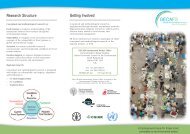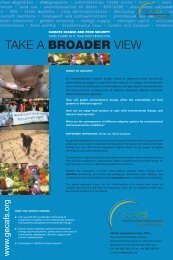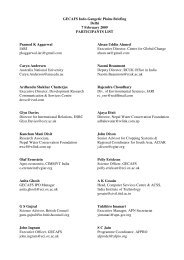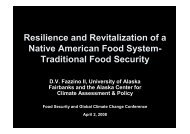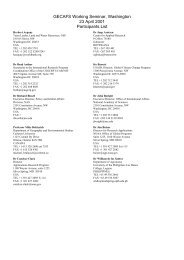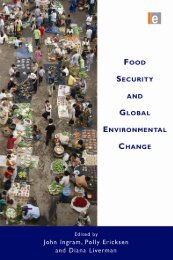Third, and of considerable practical relevance, GEC research is usually thought of as thepurview of agencies responsible for science and/or environment, whereas food securityresearch is usually thought of in terms of agriculture or aid agencies. Bringing these twogroups <strong>to</strong>gether, and finding a common agenda which appeals <strong>to</strong> their respective governanceand donor policies, is far from easy, especially as the funders and government structures thatsupport the respective research communities are not traditional collabora<strong>to</strong>rs. An encouragingdevelopment is that the international development and national security communities are nowinterested in becoming involved in such research, although they have limited ability <strong>to</strong> fundresearch without an immediate agenda for action. Within the GEC community, the ‘<strong>Global</strong>Change SysTem for Analysis, Research and Training’ (START) and GECAFS have both hadsome success on this front, while the emerging CGIAR (Consultative Group on InternationalAgricultural Research) agenda ‘Climate Change, Agriculture and <strong>Food</strong> <strong>Security</strong>’, has manyaspects specifically designed <strong>to</strong> do this (CCAFS, 2009).So who sets the GEC–food security research agenda, and how?Given the points made above, the ‘who’ is ideally the regional stakeholder community atlarge (policy advisors/makers, resource managers, researchers, NGOs donors, etc.); and the‘how’ is preferably by working interactively <strong>to</strong>gether, developing a shared vision andcommon understanding, and engendering trust. With such a broad stakeholder communitythis begs the question of how this engagement is managed, and by whom? Clearly it takestime, money and commitment, and may well result in an agenda that none of the participantsanticipated. Further, the agenda-setting process needs <strong>to</strong> be flexible <strong>to</strong> inputs from scienceand policy developments as they emerge. This allows the agenda <strong>to</strong> encompass latestthinking, and also engenders the buy-in of a wider group (geographical and/or thematic) ofstakeholders. There may also be a particular need <strong>to</strong> integrate the business sec<strong>to</strong>r and/orNGOs, and this particular dynamic is discussed in Box 4.Some final points warrant stressing when designing and undertaking research which seeks <strong>to</strong>influence policy. It is crucial <strong>to</strong> establish the information needs of the policy process early inresearch planning, and <strong>to</strong> develop the research programme accordingly. Further aspects ofparticular relevance <strong>to</strong> the science-policy debate are the requirement <strong>to</strong>: (i) establish andmaintain credibility with all stakeholders; (ii) achieve practicality; (iii) demonstrateusefulness <strong>to</strong> the designated beneficiaries; (iv) provide information <strong>to</strong> end-users in a timelyand accessible format; and (v) ensure acceptability by end-users (Ingram et al., 2007a).All these aspects will benefit from a carefully designed stakeholder engagement processwhich gives all stakeholders a sense of participation in, and joint-ownership of, the researchprocess. Finally, and although a number of options have been presented above, it is important<strong>to</strong> appreciate that local cus<strong>to</strong>ms and etiquette largely dictate the best way of establishing ‘whoneeds <strong>to</strong> know what’. Local knowledge and people are critically important.72
Box 4 Stakeholder dialogue involving the NGO and business communities.Stakeholder dialogue can only thrive in an atmosphere of cooperation and mutual understanding,while serving the interests of the participants. There is always an aspect of power in dialogue.Certainly NGOs in stakeholder dialogue have <strong>to</strong> be able <strong>to</strong> exert such power in order <strong>to</strong> be takenseriously and <strong>to</strong> negotiate acceptable results. This power could be in the magnitude of theirconstituency, their high level relations, their press contacts or their cooperation with campaigningNGOs. NGOs are not, however, a monolithic entity. For example, ‘watchdog’ NGOs, of whichGreenpeace is perhaps the most well-known example, focus on agenda-setting for public opinion andopenly confront companies on their deemed bad behaviour. This is in contrast <strong>to</strong> ‘dialogue’ NGOs(e.g. World Wide Fund for Nature, WWF), which focus on cooperation with business and otherstakeholders in common analysis and finding common solutions.While companies may not fall in<strong>to</strong> as many different categories as NGOs, there are clear differenceswithin the business sec<strong>to</strong>r. Who is actually representing the company or a group of companies canhave a strong bearing on what they are able <strong>to</strong> contribute <strong>to</strong> the dialogue and what subsequent actionsthey take. In general, public affairs managers are well trained in stakeholder dialogue, but can haveproblems with the acceptance of dialogue results within the company, while representatives frombusiness interest organizations have the responsibility <strong>to</strong> also take care of the less innovative of theirmembers. Research managers feel more comfortable with scientists than with NGO campaigners. Allthree kinds of professionals have their own multi-stakeholder networks. It is interesting <strong>to</strong> see thatthese groups of networks often have very limited overlap.When <strong>to</strong> engage stakeholders in research planningStakeholder engagement is important throughout the GEC–food security research process,not only for setting agendas. This is because the roles of non-research stakeholders include (i)identifying the problem; (ii) helping <strong>to</strong> formulate the research agenda; (iii) being sources ofinformation; (iv) being subjects of research; (v) being a target audience for dialogue on how<strong>to</strong> implement research results; (vi) implementing the research; and (vii) funding or cosponsoringthe research. Figure 2 gives a conceptual framework for organizing andunderstanding the complexity of stakeholder engagement organized around six interrelatedscience activities. These range from designing the research questions <strong>to</strong> communicating themessage. All stakeholders are represented by one of the ‘cards in the deck’, and the threedimensionaldepiction aims <strong>to</strong> capture the notion that multiple stakeholders can be involvedat various points along the six research stages.73
- Page 1 and 2:
From Food Production to Food Securi
- Page 3 and 4:
From Food Production to Food Securi
- Page 5 and 6:
Table of ContentsAbstract .........
- Page 7 and 8:
Paper 6: Undertaking Research at th
- Page 9:
AbstractFood security is a conditio
- Page 12 and 13:
2010 about 925 million people had t
- Page 14 and 15:
water) are used, and reduce negativ
- Page 16 and 17:
While the flow of the argument abou
- Page 18 and 19:
determine interactions along and be
- Page 20 and 21:
Paper 3: A Food Systems Approach to
- Page 23:
From Food Production to Food Securi
- Page 26 and 27:
concerns and are now issues that mu
- Page 28 and 29:
the relationships between GEC and f
- Page 30 and 31:
Theme 2 aims to understand how comm
- Page 32 and 33: GEC and the Food System of the Indo
- Page 34 and 35: Paper 2: The role of agronomic rese
- Page 36 and 37: These advances have resulted from a
- Page 38 and 39: Crop selection to determine mechani
- Page 40 and 41: Agronomic science is central to imp
- Page 42 and 43: Agronomic research in relation to f
- Page 44 and 45: The discussion above identifies a n
- Page 46 and 47: interventions and political inertia
- Page 48 and 49: While research on producing food ha
- Page 50 and 51: Box 1 Food system Activities and fo
- Page 52 and 53: In addition to broadening the debat
- Page 54 and 55: options. Examples already seen rang
- Page 56 and 57: Figure 3 Outcomes for 10 variables
- Page 58 and 59: Figure 4 Nine ‘planetary boundari
- Page 60 and 61: Figure 5 Environmental change, food
- Page 62 and 63: Table 1: Indicative analysis of the
- Page 65: From Food Production to Food Securi
- Page 68 and 69: Trade Agreement (NAFTA) and the Eur
- Page 70 and 71: Parry et al., 2005). Conducting foo
- Page 72 and 73: is provided in the ESF/COST Forward
- Page 74 and 75: Paper 5: Engaging Stakeholders at t
- Page 76 and 77: into actions (strategies, policies,
- Page 78 and 79: Box 2 Engaging with stakeholders in
- Page 80 and 81: Box 3 Setting the research agenda f
- Page 84 and 85: Figure 2: Organizing and understand
- Page 86 and 87: organizations made up of numerous n
- Page 88 and 89: Elements of good practice in stakeh
- Page 90 and 91: Finally, it is worth noting that fo
- Page 92 and 93: development (Lee, 1999; Gunderson a
- Page 94 and 95: Box 7 The GECAFS stakeholder survey
- Page 96 and 97: ‘break down’ what might be a hi
- Page 98 and 99: Paper 6: Undertaking Research at th
- Page 100 and 101: agriculture in many parts of the wo
- Page 102 and 103: gaps. The presence of a strong tech
- Page 104 and 105: an average of two years to coalesce
- Page 106 and 107: Institute for Meteorology and Hydro
- Page 108 and 109: Identifying case study sitesResearc
- Page 110 and 111: can both benefit from and contribut
- Page 112 and 113: Box 5 Mapping stakeholder interests
- Page 114 and 115: Holding planning meetings in locati
- Page 116 and 117: This reorientation of the debate fr
- Page 118 and 119: Importance of this type of research
- Page 120 and 121: Integrating the food system concept
- Page 122 and 123: awareness of the GEC issues within
- Page 124 and 125: pollutants were then introduced as
- Page 126 and 127: communities operating in food syste
- Page 128 and 129: Improving input-use efficiency acro
- Page 130 and 131: governance focuses on the range of
- Page 132 and 133:
Developing research agendas in supp
- Page 134 and 135:
The renewed approach to interdiscip
- Page 136 and 137:
BIELAK, A., HOLMES, J., SAVGÅRD, J
- Page 138 and 139:
EAKIN, H. 2010. What is Vulnerable?
- Page 140 and 141:
GODFRAY, H. C. J., BEDDINGTON, J. R
- Page 142 and 143:
INGRAM, J. S. I. & FERNANDES, E. C.
- Page 144 and 145:
LYUTSE, S. 2010. The One Billion To
- Page 146 and 147:
RAYNER, S. & MALONE, E. L. 1998. Hu
- Page 148 and 149:
UNDP 2006. The 2006 Human Developme
- Page 150 and 151:
activities “from plough to plate
- Page 152 and 153:
contribution to the science agenda:
- Page 154 and 155:
urgently needed, and - given the gr
- Page 156 and 157:
GECAFS plannenmakerij stelde vast d
- Page 158 and 159:
ieder hun eigen groep van betrokken
- Page 160 and 161:
het gebied van beheer hebben betrek
- Page 162:
Curriculum VitaeFollowing a BSc in



